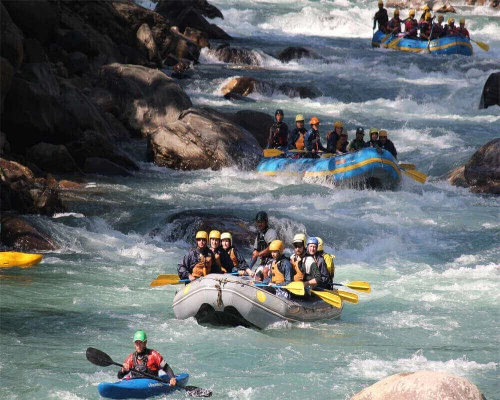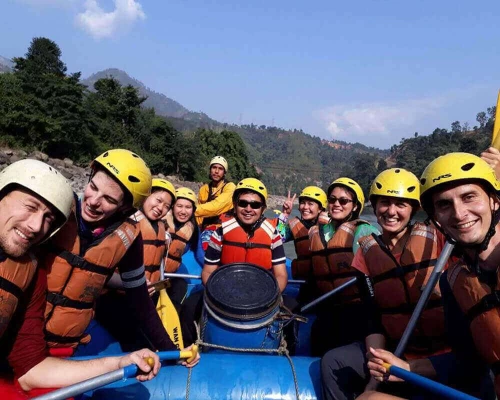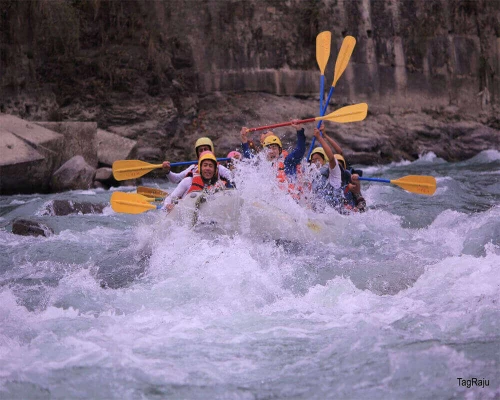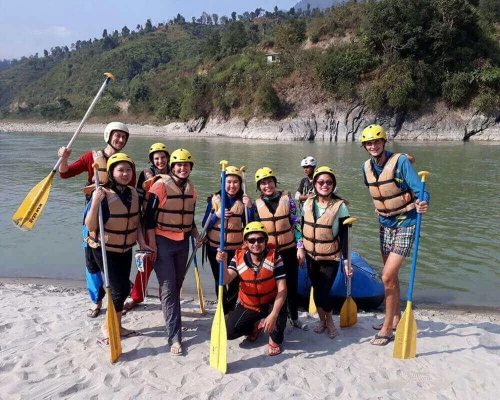The name of this river is after a legend that says, high in the Himalaya at Gosainkund the god Shiva drove his trident into the ground to create three springs –the source of the river and hence its name Trishuli.The river has carved some truly impressive gorges in its lower part as it cut its way through the 2000 meter high Mahavarat Range. These gorges are also the rout flowed by the main Prithivi Highway and the road diesel trucks undoubtedly detract from the River itself. The opposite side to the road is relatively wild and you should see some wildlife, a profusion of colorful bird, including eagles and vultures.
For many people this river represents the ideal compromise rafting trip: just the right length of time, exhilarating rapid, but not too difficult, easily accessible from Kathmandu. Certainly if you’re looking for more of a ‘wilderness’ experience unsullied beaches, no other rafting groups, and un-spoilt scenery then you should consider one of the other river.The rapid on Trisuli are mainly big, bouncy and relatively safe; ‘flips’ (where the raft capsizes) or other accidents are rare in normal water condition, and if you wish, it is possible to walk around the few difficult rapid. Since the highway follows the river you can easily come back to Kathmandu in few hours after completion of the trip.
Best time to do Trishuli River Rafting
The best time for Trishuli River rafting in Nepal is during the post-monsoon season (September to November) and the pre-monsoon season (March to May). These periods offer ideal conditions with moderate water levels, providing thrilling rapids and a memorable rafting experience. The weather is generally clear and mild, creating a perfect combination of adventure and enjoyable surroundings.
Trishuli River Rafting in autumn season (Sept – Nov)
Rafting in the Trishuli River during the autumn season is considered an excellent choice. This period is marked by post-monsoon conditions which offers an ideal balance between water levels and weather. The monsoon rains have settled, resulting in moderate river levels that provide exciting rapids without the excessive turbulence seen during the monsoon season. The weather is typically clear and mild which creates a pleasant environment for rafting enthusiasts. The clear skies and pleasant temperatures create a comfortable environment for rafting, allowing you to fully enjoy the scenic beauty and exciting rapids of this iconic river, all within a day's trip from the capital city of Kathmandu. The lush greenery along the riverbanks adds more to the scenic beauty which enhance the overall experience.
Trishuli River Rafting in winter season (Dec- Feb)
Trishuli River Rafting during the winter season presents a different set of considerations. During these months, the water levels may be lower, and the weather can be colder, impacting the overall rafting experience. While the serene beauty of the winter landscape along the riverbanks can be captivating, rafters should be prepared for cooler temperatures. The lower water levels may result in less intense rapids compared to other seasons, making it a potentially more tranquil experience suitable for those who prefer a milder adventure. However, it's crucial to stay informed about the specific conditions during the chosen period and to dress accordingly for the cooler weather.
Trishuli River Rafting in spring season (March- May)
Embarking on Trishuli River rafting during the spring season offers an exhilarating adventure in the favorable conditions. As winter ends, the weather begins to warm up creating a pleasant environment for rafting enthusiasts. The river is fed by the melting snow from the Himalayas which maintains a moderate flow and also provides exciting rapids that cater to both beginner and experienced rafters. The landscape bursts into vibrant colors with blooming flowers and lush greenery, enhancing the scenic beauty along the riverbanks. The spring season strikes a balance between enjoyable water levels and comfortable temperatures by making it an ideal time for a memorable rafting experience.
Trishuli River Rafting in monsoon season (Jun - Aug)
Trishuli River rafting during the monsoon season comes with its own set of considerations and challenges. This period is characterized by heavy rainfall, leading to increased water levels in the river. While the Trishuli River is renowned for its exhilarating rapids, the monsoon season can make the water currents stormier and potentially dangerous. Rafters should be prepared for a more strong and challenging experience. However, safety remains a top priority during this season, and it is crucial to adhere to the guidance of experienced guides and local rafting operators.
Important Notes during Trishuli River Rafting
- While booking, we need the photocopy of your passport and you have to pay us a minimum of 10% payment of the total cost as advance.
- Always attend the pre-rafting safety briefing conducted by experienced guides.
- Wear the provided safety gear correctly and securely. This includes a life jacket and helmet. Properly fitted gear is essential for your safety during the rafting journey.
- Listen carefully to the instructions given by the rafting guide. Clear communication is vital for navigating rapids, following the planned route, and responding to changing river conditions.
- Be aware that rafting involves physical exertion. Inform the guides of any health conditions or concerns beforehand.
- In the event of turnover, listen to the guide's instructions on how to re-enter the raft safely. Stay calm and follow the recommended procedures to minimize risks.
- Beverages, snacks, are not included in our packages, so you have to pay additional cash.








